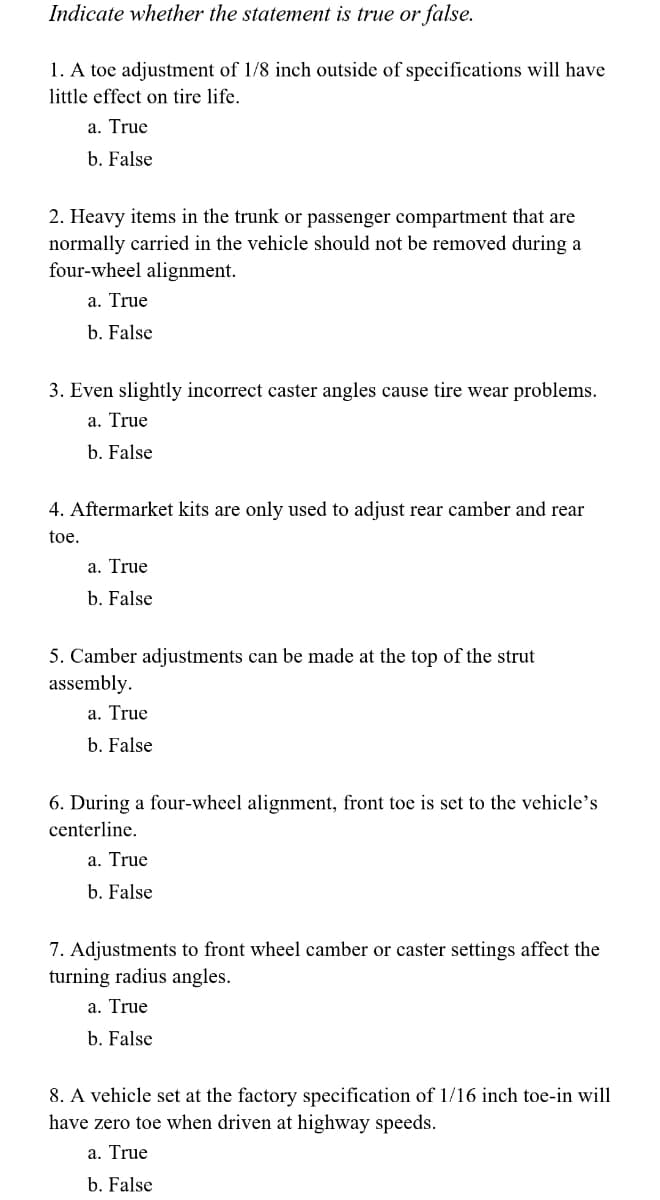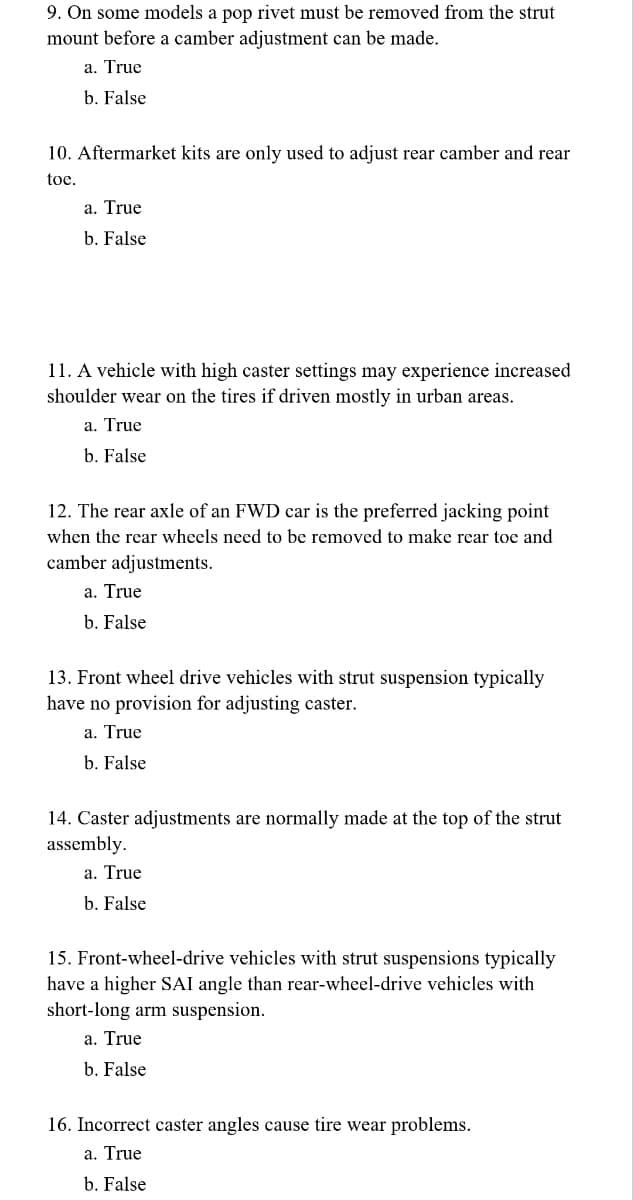1. A toe adjustment of 1/8 inch outside of specifications will have little effect on tire life. a. True b. False 2. Heavy items in the trunk or passenger compartment that are normally carried in the vehicle should not be removed during a four-wheel alignment. a. True b. False 3. Even slightly incorrect caster angles cause tire wear problems. a. True b. False
1. A toe adjustment of 1/8 inch outside of specifications will have little effect on tire life. a. True b. False 2. Heavy items in the trunk or passenger compartment that are normally carried in the vehicle should not be removed during a four-wheel alignment. a. True b. False 3. Even slightly incorrect caster angles cause tire wear problems. a. True b. False
Automotive Technology: A Systems Approach (MindTap Course List)
6th Edition
ISBN:9781133612315
Author:Jack Erjavec, Rob Thompson
Publisher:Jack Erjavec, Rob Thompson
Chapter45: Tires And Wheels
Section: Chapter Questions
Problem 4ASRQ: Technician A says that replacement wheel rims should be the same as the original equipment wheels in...
Related questions
Question
Hello, I am trying to study for a test and found this practice review but I'd like to be able to check my work. Can someone help answer some of these questions? Thank you

Transcribed Image Text:Indicate whether the statement is true or false.
1. A toe adjustment of 1/8 inch outside of specifications will have
little effect on tire life.
a. True
b. False
2. Heavy items in the trunk or passenger compartment that are
normally carried in the vehicle should not be removed during a
four-wheel alignment.
a. True
b. False
3. Even slightly incorrect caster angles cause tire wear problems.
a. True
b. False
4. Aftermarket kits are only used to adjust rear camber and rear
toe.
a. True
b. False
5. Camber adjustments can be made at the top of the strut
assembly.
a. True
b. False
6. During a four-wheel alignment, front toe is set to the vehicle's
centerline.
a. True
b. False
7. Adjustments to front wheel camber or caster settings affect the
turning radius angles.
a. True
b. False
8. A vehicle set at the factory specification of 1/16 inch toe-in will
have zero toe when driven at highway speeds.
a. True
b. False

Transcribed Image Text:9. On some models a pop rivet must be removed from the strut
mount before a camber adjustment can be made.
a. True
b. False
10. Aftermarket kits are only used to adjust rear camber and rear
toe.
a. True
b. False
11. A vehicle with high caster settings may experience increased
shoulder wear on the tires if driven mostly in urban areas.
a. True
b. False
12. The rear axle of an FWD car is the preferred jacking point
when the rear wheels need to be removed to make rear toe and
camber adjustments.
a. True
b. False
13. Front wheel drive vehicles with strut suspension typically
have no provision for adjusting caster.
a. True
b. False
14. Caster adjustments are normally made at the top of the strut
assembly.
a. True
b. False
15. Front-wheel-drive vehicles with strut suspensions typically
have a higher SAI angle than rear-wheel-drive vehicles with
short-long arm suspension.
a. True
b. False
16. Incorrect caster angles cause tire wear problems.
a. True
b. False
Expert Solution
This question has been solved!
Explore an expertly crafted, step-by-step solution for a thorough understanding of key concepts.
This is a popular solution!
Trending now
This is a popular solution!
Step by step
Solved in 2 steps

Knowledge Booster
Learn more about
Need a deep-dive on the concept behind this application? Look no further. Learn more about this topic, mechanical-engineering and related others by exploring similar questions and additional content below.Recommended textbooks for you

Automotive Technology: A Systems Approach (MindTa…
Mechanical Engineering
ISBN:
9781133612315
Author:
Jack Erjavec, Rob Thompson
Publisher:
Cengage Learning

Automotive Technology
Mechanical Engineering
ISBN:
9781337794213
Author:
ERJAVEC, Jack.
Publisher:
Cengage,

Automotive Technology: A Systems Approach (MindTa…
Mechanical Engineering
ISBN:
9781133612315
Author:
Jack Erjavec, Rob Thompson
Publisher:
Cengage Learning

Automotive Technology
Mechanical Engineering
ISBN:
9781337794213
Author:
ERJAVEC, Jack.
Publisher:
Cengage,